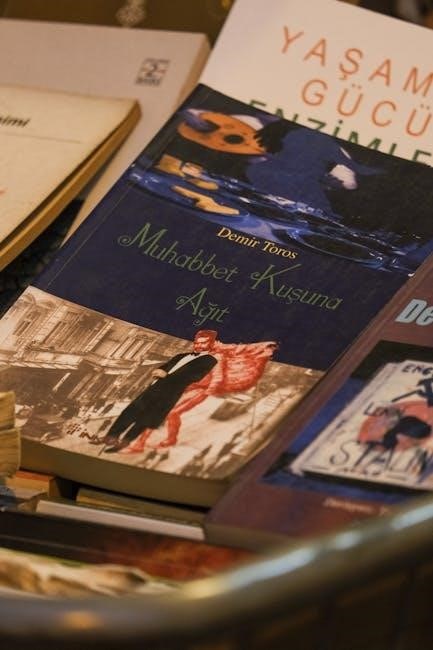Written in Bone, by renowned forensic anthropologist Sue Black, is a captivating exploration of how human remains reveal secrets about life, death, and identity, blending science with storytelling.
The Book’s Title, Author, and Award Recognition
Written in Bone: Hidden Stories in What We Leave Behind is authored by the acclaimed forensic anthropologist Sue Black. The book has garnered significant recognition, including the prestigious Crime Writers’ Association (CWA) Gold Dagger for Non-Fiction 2021. This award underscores the book’s compelling narrative and scientific depth. Black, known for her earlier work All That Remains, brings her vast expertise in forensic anthropology to this latest publication, further cementing her reputation as a leading voice in the field. The book’s title reflects its central theme of uncovering the stories hidden within human remains, making it a standout work in both forensic science and narrative non-fiction.
Overview of the Book’s Structure and Content
Written in Bone is structured as a comprehensive journey through the human skeleton, guiding readers from the skull to the toes. Each chapter focuses on specific bones, detailing their biology, development, and the secrets they hold about an individual’s life and death. The book seamlessly weaves scientific explanations with engaging anecdotes from Sue Black’s career, showcasing how forensic anthropology solves crimes and identifies remains. Real-life case studies highlight the practical applications of bone analysis, while the narrative maintains a balance between scientific rigor and storytelling. This approach makes the book accessible to both experts and general readers, offering a fascinating blend of science, history, and human stories.

The Author: Sue Black’s Background and Expertise
Sue Black, a world-renowned forensic anthropologist and professor, brings unparalleled expertise in human anatomy and death investigation. Her work has earned her the title of Dame Commander.
Biography of Sue Black and Her Contributions to Forensic Anthropology
Sue Black is a leading forensic anthropologist and anatomist, renowned for her groundbreaking work in identifying human remains. Born in Scotland, she developed an early fascination with human anatomy, which led her to pursue a career in forensic science. Black earned her PhD in forensic anthropology and quickly rose to prominence through her meticulous analysis of skeletal remains. Her expertise has been instrumental in solving high-profile criminal cases and uncovering historical secrets. As a professor and researcher, she has trained generations of forensic scientists. Black’s work has earned her numerous accolades, including the prestigious CWA Gold Dagger for Non-Fiction for her book Written in Bone. Her contributions to the field have significantly advanced the understanding of human remains and their role in criminal investigations.
Her Previous Work: “All That Remains”
All That Remains, Sue Black’s earlier memoir, delves into her life’s work as a forensic anthropologist, offering a deeply personal and scientific exploration of death. The book recounts her career, from analyzing skeletal remains to solving crimes, blending storytelling with scientific insight. It reflects on the emotional and ethical challenges of her work, showcasing her unique perspective on mortality. All That Remains received critical acclaim, praised for its frank yet compassionate approach to a subject often shrouded in mystery. It established Black as a compelling voice in the field, setting the stage for her subsequent work in Written in Bone.

The Science of Bones: Key Concepts in Forensic Anthropology
Forensic anthropology involves analyzing human remains to uncover details about identity, lifestyle, and cause of death, relying on bone biology and developmental insights to aid criminal investigations.
Understanding Bone Biology and Development

Bone biology reveals how bones grow, develop, and adapt throughout life. From cartilage templates to fully formed structures, bones undergo constant remodeling, reflecting lifestyle, diet, and environmental factors. This process leaves imprints, such as stress marks or nutrient deficiencies, which forensic anthropologists analyze. The human skeleton regenerates every 15 years, yet retains a record of past experiences. Understanding bone development is crucial for reconstructing identities and solving crimes, as it provides insights into age, health, and ancestry, making bones invaluable storytellers of a person’s life history.
The Role of Forensic Anthropology in Criminal Investigations

Forensic anthropology plays a pivotal role in criminal investigations by analyzing human remains to uncover vital information. Experts like Sue Black examine bones to determine age, sex, ancestry, and cause of death, aiding in identifying victims and solving crimes. By studying skeletal fragments, forensic anthropologists reconstruct life histories and death circumstances, providing critical evidence for legal cases. This science bridges the gap between biology and justice, helping investigators piece together events surrounding a person’s demise. The meticulous analysis of bones, even small fragments, offers insights that are often key to resolving mysteries and ensuring accountability.
How Bones Reveal Secrets About a Person’s Life and Death
Bones are physical archives of a person’s life, capturing their identity, origins, lifestyle, and the circumstances surrounding their death. Through meticulous examination, forensic anthropologists like Sue Black uncover secrets embedded in skeletal remains. Bones reveal age, sex, ancestry, and health conditions, while fractures and trauma provide clues about a person’s demise. Even small fragments can offer insights into a life lived, as bones constantly remodel throughout life, acting as dynamic records of existence. For instance, horse tail bones can resemble human finger bones, while eye socket placement reveals whether an animal was a hunter or prey. These skeletal clues are vital in criminal investigations, making bones the last sentinels of life’s story.

The Book’s Central Theme: The Human Skeleton as a Storyteller
Written in Bone explores how the human skeleton acts as a storyteller, revealing life stories, identity, and death circumstances. Sue Black masterfully deciphers these skeletal narratives, guiding readers through the anatomy and its secrets, showcasing how bones bear witness to lives lived.
From Skull to Toes: A Journey Through the Human Skeleton
Sue Black takes readers on a fascinating journey through the human skeleton, from the skull to the toes, explaining how each bone reveals details about a person’s life and death. She explores how the skull reflects ancestry, diet, and trauma, while the spine and ribs provide insights into health and lifestyle. The pelvis and long bones, meanwhile, hold clues about age, gender, and physical activity. Black illustrates her points with real-life case studies, showing how forensic anthropologists use skeletal remains to solve crimes and uncover historical truths. Her narrative combines scientific precision with storytelling, making the complexities of bone analysis accessible and engaging for all readers. This journey through the skeleton underscores the profound stories hidden within our bones.
Case Studies: Real-Life Examples of Bone Analysis
Sue Black enriches her narrative with compelling case studies, showcasing how bone analysis solves crimes and identifies remains. One notable example involves a suitcase containing skeletal fragments, where Black’s expertise determined the victim’s identity through tiny bone details. Another case highlights her work in crypts, using historical bones to reconstruct past lives. These real-life examples illustrate the precision and humanity in forensic anthropology, blending science with storytelling to reveal the hidden stories of human remains. Her accounts, both fascinating and poignant, demonstrate how bones serve as silent witnesses to history and justice, making Written in Bone a gripping and educational read.
The Emotional and Scientific Connection to Human Remains
Sue Black masterfully weaves the emotional and scientific aspects of working with human remains, highlighting the respect and compassion she brings to her work. She shares personal anecdotes, revealing the deep humanity behind forensic anthropology, while explaining the meticulous science involved in bone analysis. This dual perspective balances the technical details of her craft with the profound stories behind each set of remains, emphasizing the importance of treating every individual with dignity; Through her narrative, Black bridges the gap between the cold facts of science and the poignant reality of loss, creating a connection that resonates deeply with readers. Her approach underscores the ethical and emotional dimensions of her field, making her work both scientifically rigorous and deeply human.

Practical Applications of Forensic Anthropology
Forensic anthropology aids in solving crimes by analyzing bones to identify individuals, determine cause of death, and reconstruct life histories, providing crucial evidence for justice. Bones reveal secrets about a person’s life, such as age, gender, and health, aiding investigators in piecing together the past. This scientific discipline is essential in legal and historical contexts, offering insights that help solve mysteries and bring closure to families. By studying human remains, forensic anthropologists uncover the stories hidden in bones, making them indispensable in both modern and historical investigations.

Solving Crimes Through Bone Analysis
Forensic anthropology plays a pivotal role in criminal investigations by analyzing human remains to uncover crucial evidence. Bones reveal details such as age, gender, and health, aiding in victim identification. Trauma marks on skeletal remains can indicate cause of death, while skeletal anomalies may link remains to missing persons. Forensic experts like Sue Black use these insights to reconstruct life histories, helping investigators piece together events surrounding a death. This scientific approach has been instrumental in solving high-profile cases, demonstrating the power of bone analysis in delivering justice and closure for families. By deciphering the stories hidden in bones, forensic anthropologists bridge the gap between mystery and resolution, proving indispensable in modern criminal investigations.
Identifying Human Remains in Historical and Modern Contexts
Forensic anthropology is instrumental in identifying human remains across historical and modern contexts, providing insights into identity, origins, and circumstances of death. Historically, bones from archaeological sites or cold cases are analyzed for clues about past lives, while modern investigations use advanced techniques like DNA and 3D reconstruction for rapid identification. Sue Black highlights how these methods bridge time, linking the past to the present. This dual application underscores the enduring relevance of bone analysis in uncovering truths, whether in ancient graves or contemporary crime scenes, demonstrating the versatility of forensic science in solving mysteries across eras.
Ethical Considerations in Forensic Science

Ethical considerations in forensic science are crucial, ensuring respect for the deceased and fairness in legal processes. Sue Black emphasizes the importance of maintaining dignity and privacy when handling remains. Issues like consent, cultural sensitivity, and avoiding bias are paramount. Technological advancements raise questions about data privacy and the potential misuse of forensic tools. Black advocates for transparency and accountability to uphold justice and trust in scientific methods. Balancing scientific rigor with ethical responsibility is essential in forensic anthropology, reflecting a commitment to truth and humanity. These principles guide professionals in navigating complex cases with integrity and compassion.

Book Reviews and Reception
Written in Bone has garnered widespread acclaim, winning the CWA Gold Dagger for Non-Fiction. Reviewers praise its gripping storytelling, scientific depth, and humanity, making it a standout read.
Critical Acclaim and Awards
Written in Bone has received high praise from critics and experts alike. It won the prestigious Crime Writers’ Association (CWA) ALCS Gold Dagger for Non-Fiction in 2021, solidifying its place in forensic literature. Renowned authors like Kathy Reichs and Dr. Richard Shepherd have praised the book for its vivid storytelling and scientific precision. Reviewers highlight its ability to weave real-life crime scenarios with detailed bone analysis, making it both educational and engaging. The book’s unique blend of humanity and forensic science has been lauded as a standout in its genre, earning it a place among the most recommended reads in true crime and forensic anthropology. Its acclaim underscores its impact on both public understanding and the field of forensic science.
Reader Feedback and Popular Reception
Written in Bone has captivated readers worldwide, earning a 4.6-star rating on Amazon with over 2,195 reviews. Readers praise its unique blend of science, storytelling, and humor, making it accessible to both experts and general audiences. Many highlight its ability to balance the grim nature of forensic work with a compassionate and engaging narrative. The book’s real-life crime scenarios and vivid case studies resonate deeply, drawing comparisons to CSI dramas. Its popularity extends beyond true crime enthusiasts, appealing to anyone fascinated by human biology and history. The book’s relatability and Sue Black’s witty style have made it a favorite among readers seeking a gripping yet insightful read.
Comparison with Other Works in the Genre
Written in Bone stands out in the true crime and forensic science genre, often compared to works by Kathy Reichs and Dr. Richard Shepherd. While Reichs’ Temperance Brennan series focuses on fictional crime-solving, Black’s narrative offers a real-life, scientifically grounded perspective. Similarly, Shepherd’s Unnatural Causes delves into forensic pathology, but Black’s approach uniquely combines detailed bone analysis with personal anecdotes. Her ability to weave humor and humanity into the darkness of death sets her apart, making Written in Bone a standout in the genre, appealing to fans of both science and storytelling. This blend of expertise and accessibility has solidified its place alongside other leading works in forensic literature.
Written in Bone leaves a transformative legacy in forensic science, bridging human stories with scientific rigor, ensuring its relevance for future generations. Sue Black’s work endures.
The Book’s Impact on Forensic Science and Public Understanding
Written in Bone has profoundly influenced forensic science by showcasing how bones reveal life stories, aiding criminal investigations and historical identifications. Its accessible storytelling has bridged the gap between complex scientific concepts and public understanding, fostering greater appreciation for forensic anthropology. By detailing real-life cases, Sue Black demonstrates the critical role of bones in solving crimes and uncovering historical truths, inspiring future professionals in the field. The book’s success lies in its ability to humanize science, making it relatable and engaging while highlighting the ethical considerations in forensic work. Ultimately, it has expanded public awareness of death’s role in life, leaving a lasting legacy in both science and popular culture.
Sue Black’s Vision for the Future of Forensic Anthropology
Dame Sue Black envisions a future where forensic anthropology becomes more integrated with cutting-edge technologies, enhancing precision in identifying remains and solving crimes. She advocates for increased collaboration between experts worldwide to share knowledge and improve ethical standards. Black emphasizes the importance of education and public engagement to demystify death and promote a deeper understanding of forensic science. Her vision includes advancing the field’s role in humanitarian efforts, such as identifying victims of conflicts and disasters. By inspiring the next generation of scientists, Black aims to ensure that forensic anthropology continues to evolve, providing critical insights into human history and justice systems globally.
